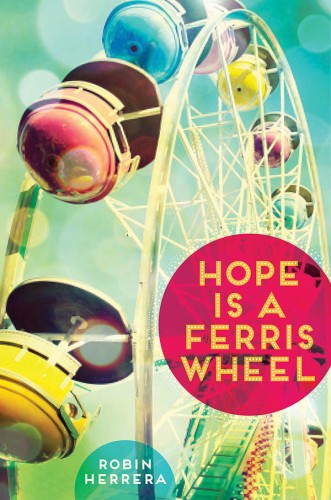 “Hope is the thing with feathers-/that perches in the soul,” wrote Emily Dickinson, but ten-year-old Star Mackie isn’t so sure that’s true. For Star, the main character in Robin Herrera’s inaugural novel Hope Is A Ferris Wheel, hope is a Ferris wheel, and loneliness is perching in her soul. Star has an empty space in her heart and soul where her dad is supposed to be. Neither her mom nor her sixteen- year-old sister Winter will talk about Dad, but he is in Star’s head, “making [her] hope for things like birthday cards and ice cream dates and whatever else fathers and daughters [do] together” (113).
“Hope is the thing with feathers-/that perches in the soul,” wrote Emily Dickinson, but ten-year-old Star Mackie isn’t so sure that’s true. For Star, the main character in Robin Herrera’s inaugural novel Hope Is A Ferris Wheel, hope is a Ferris wheel, and loneliness is perching in her soul. Star has an empty space in her heart and soul where her dad is supposed to be. Neither her mom nor her sixteen- year-old sister Winter will talk about Dad, but he is in Star’s head, “making [her] hope for things like birthday cards and ice cream dates and whatever else fathers and daughters [do] together” (113).
Fifth grader Star has recently moved from Oregon to California, and the social situation at Pepperwood Elementary presents multiple challenges. Not only has she been dubbed Trashy Mackie since she lives in the trailer park, Treasure Trailers, she is called Mullet to identify her layered cut and blue hair. To convince everyone to be more open-minded about trailer parks and layered cuts, she forms the Trailer Park Club. When the club attracts only two members, Denny and Genny Libra, Star changes the name to the Emily Dickinson Club to honor her favorite poet.
With the poetry focus, she attracts Langston and Eddie, a couple of “delinquents” from detention whom she meets after earning detention for refusing to turn in her vocabulary sentences assigned by Mr. Savage. These sentences are one of the best parts of the book! In them, she writes through her anxiety and voices her concerns about her sister, Winter, who has grown depressed. Because Winter writes blood bath horror stories that would rival those written by Stephen King, she gets sent to Sarah Borne Alternative School where she hooks up with Allie Libra. After their breakup, she carries a big sadness like that carried by Emily Dickinson.
As her life spins out of control, Star decides hope might be more like a Gravitron: It looks fun at first, but it spins so fast her head pounds, she vomits, and she can’t walk for the dizziness. Winter tells Star that sometimes hope isn’t enough. She wishes hope were more like a rampart, “something [she] could build up to protect [herself] when bad things happen. That would be a lot more useful than something that just perches there, waiting, or spins, sometimes without stopping” (182). By the story’s end, though, Star learns that sometimes hope is exactly what she needs to keep her dreams alive.
- Posted by Donna
